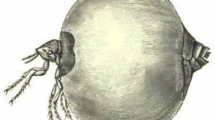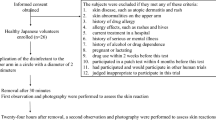Abstract
Dermatitis caused by penetrating bird schistosome cercariae is an emerging global public health problem. Infections may be prevented by the use of topical formulations that inhibit cercarial skin penetration. We evaluated nine water resistant formulations by exposing treated arms of volunteers to Trichobilharzia szidati cercariae. Six formulations protected from cercarial invasion. However, after immersion of the treated skin in water (2 × 20 min), only two formulations offered full protection: (1) Safe Sea™, a cream protecting against jelly fish, (2) niclosamide in water resistant sun protecting cream formulations at concentrations as low as 0.05%. In an in vitro system Safe Sea™ and a 0.1% niclosamide formulation caused a high damage rate in T. szidati (92% and 99% after 5 min; only niclosamide with lethal effect) but not in Schistosoma mansoni (1% and 72%; both formulations with lethal effect). However, a 1% niclosamide formulation damaged S. mansoni sufficiently (100% after 5 min) and might offer full penetration protection.


Similar content being viewed by others
References
Abu-Elyazeed RR, Podgore JK, Mansour NS, Kilpatrick ME (1993) Field trial of 1% niclosamide as a topical antipenetrant to Schistosoma mansoni cercariae. Am J Trop Med Hyg 49:403–409
Allerberger F, Wötzer G, Dierich MP, Moritz C, Fritsch P, Haas W (1994) Auftreten von Badedermatitis in Tirol. Immun Infect 22:30–32
Andrews P, Thyssen J, Lorke D (1982) The biology and toxicology of molluscicides, Bayluscide. Pharmacol Ther 19:245–295
Appelton CC, Brock K (1986) The penetration of mammalian skin by cercariae of Trichobilharzia sp. (Trematoda: Schistosomatidae) from South Africa. Onderstepoort J Vet Res 53:209–211
Bayssade-Dufour C, Martins C, Vuong PN (2001) Histopathologie pulmonaire d’un modèle mammifère et dermatite cercarienne humaine. Med Mal Infect 31:713–722
Bruce JI, Miller R, Lightner L, Yoganathan S (1992) Efficacy of Niclosamide as a potential topical antipenetrant (TAP) against cercariae of Schistosoma mansoni in monkeys. Mem Inst Oswaldo Cruz 87:281–289
Caumes E, Felder-Moinet S, Couzigou C, Darras-Joly C, Latour P, Léger N (2003) Failure of an ointment based on IR3535 (ethylbutylacetylaminopropionate) to prevent an outbreak of cercarial dermatitis during swimming races across Lake Annecy, France. Ann Trop Med Parasitol 97:157–163
Chamot E, Toscani L, Rougemont A (1998) Public health importance and risk factors for cercarial dermatitis associated with swimming in Lake Leman at Geneva, Switzerland. Epidemiol Infect 120:305–314
Cherfas J (1989) New weapon in the war against schistosomiasis. Science 246:1242–1243
Cohen FE, Gregoret LM, Amiri P, Aldape K, Railey J, McKerrow JH (1991) Arresting tissue invasion of a parasite by protease inhibitors chosen with the aid of computer modelling. Biochemistry 30:11221–11229
de Gentile L, Picot H, Bourdeau P, Bardet R, Kerjan A, Piriou M, Le Guennic A, Bayssade-Dufour C, Chabasse D, Mott KE (1996) Cercarial dermatitis in Europe: a new public health problem? Bull World Health Organ 74:159–163
Ercoli N, Payares G, Nuñez D (1985) Schistosoma mansoni: neurotransmitters and the mobility of cercariae and schistosomules. Exp Parasitol 59:204–216
Fischer H, Reimann H (2006) Rezeptur gegen Badedermatitis. http://www.pharmazeutische-zeitung.de/index.php Cited 26/2006
Fradin MS, Day JF (2002) Comparative efficacy of insect repellents against mosquito bites. N Engl J Med 347:13–18
Haas W, Pietsch U (1991) Migration of Trichobilharzia ocellata schistosomula in the duck and in the abnormal murine host. Parasitol Res 77:642–644
Haas W, van de Roemer A (1998) Invasion of the vertebrate skin by cercariae of Trichobilharzia ocellata: penetration processes and stimulating cues. Parasitol Res 84:787–795
Hoeffler DF (1974) Cercarial dermatitis. Arch Environ Health 29:225–229
Horák P, Kolářová L (2000) Survival of bird schistosomes in mammalian lungs. Int J Parasitol 30:65–68
Horák P, Dvořák J, Kolářová L, Trefil L (1999) Trichobilharzia regenti, a pathogen of the avian and mammalian central nervous systems. Parasitology 119:577–581
Horák P, Kolářová L, Adema CM (2002) Biology of the schistosome genus Trichobilharzia. Adv Parasitol 52:155–233
Hrádková K, Horák P (2002) Neurotropic behaviour of Trichobilharzia regenti in ducks and mice. J Helminthol 76:137–141
Ingram RJ, Bartlett A, Brown MB, Marriott C, Whitfield RJ (2002) Dimethicone barrier cream prevents infection of human skin by schistosome cercariae: evidence from Franz cell studies. J Parasitol 88:399–402
Kock S (2001) Investigations on intermediate host specificity help to elucidate the taxonomic status of Trichobilharzia ocellata (Digenea: Schistosomatidae). Parasitology 123:67–70
Kolářová L, Horák P, Sitko J (1997) Cercarial dermatitis in focus: schistosomes in the Czech Republic. Helminthologia 34:127–139
Lim KC, Sun E, Bahgat M, Bucks D, Guy R, Hinz RS, Cullander C, McKerrow JH (1999) Blockage of skin invasion by schistosome cercariae by serine protease inhibitors. Am J Trop Med Hyg 60:487–492
MacFarlane WV (1949) Schistosome dermatitis in New Zealand. II. Pathology and immunology of cercarial lesions. Am J Hyg 50:152–167
Neuhaus W (1952) Biologie und Entwicklung von Trichobilharzia szidati n. sp. (Trematoda, Schistosomatidae), einem Erreger von Dermatitis beim Menschen. Z Parasitenkd 15:203–266
Odening K (1996) What Cercaria ocellata actually is. Acta Parasitologica Turcica 20:387–397
Olivier L (1953) Observations on the migrations of avian schistosomes in mammals previously unexposed to cercariae. J Parasitol 39:237–243
Pellegrino J (1967) Protection against human schistosome cercariae. Exp Parasitol 21:112–131
Ramaswamy K, He YX, Salafsky B, Shibuya T (2003) Topical application of DEET for schistosomiasis. Trends Parasitol 19:551–555
Rudolfová J, Hampl V, Bayssade-Dufour C, Lockyer AE, Littlewood DTJ, Horák P (2005) Validity reassessment of Trichobilharzia species using Lymnaea stagnalis as the intermediate host. Parasitol Res 95:79–89
Salafsky B, Ramaswamy K, He YX, Li J, Shibuya T (1999) Development and evaluation of LIPODEET, a new long-acting formulation of N,N-diethyl-m-toluamide (DEET) for the prevention of schistosomiasis. Am J Trop Med Hyg 61:743–750
Werner S, Fiedler W, Güde H, Haas W, Hertel J, Ostendorp W, Kimmig P, Kirch A, Rothhaupt K-O, Sproll A, Winterer H, Wulff C (2005) Badedermatitis: Ökologie und Auftreten des Auslösers Trichobilharzia franki am Bodensee und Entwicklung von Maßnahmen zur Verminderung des Befalls. Schrift Verein Gesch Bodensee Umgeb 123:257–274
Yang KL, Tchou TK, T’ang CC, Ho TK, Luo HC (1965) A study on dermatitis in rice farmers. Chin Med J 84:143–159
Acknowledgements
The authors would like to thank Bayer chemicals and Wacker chemicals, Germany, and Dr. G. Steidl for kindly providing us with the agents, the parasitology group of the University of Erlangen-Nuremberg for participating as volunteers and Korinna Kedves for the advice. This work was supported by the Baden-Württembergisches Sozialministerium, by the Deutsche Forschungsgemeinschaft and communities at lake Bodensee, Germany. The experiments comply with the current laws of Germany.
Author information
Authors and Affiliations
Corresponding author
Rights and permissions
About this article
Cite this article
Wulff, C., Haeberlein, S. & Haas, W. Cream formulations protecting against cercarial dermatitis by Trichobilharzia . Parasitol Res 101, 91–97 (2007). https://doi.org/10.1007/s00436-006-0431-5
Received:
Accepted:
Published:
Issue Date:
DOI: https://doi.org/10.1007/s00436-006-0431-5




